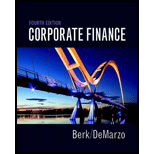
Corporate Finance (4th Edition) (Pearson Series in Finance) - Standalone book
4th Edition
ISBN: 9780134083278
Author: Jonathan Berk, Peter DeMarzo
Publisher: PEARSON
expand_more
expand_more
format_list_bulleted
Textbook Question
Chapter 21.4, Problem 2CC
What is the leverage ratio of a call?
Expert Solution & Answer
Want to see the full answer?
Check out a sample textbook solution
Students have asked these similar questions
Choose correct solution pl
Company A problem.
no ai
Question three solve
Chapter 21 Solutions
Corporate Finance (4th Edition) (Pearson Series in Finance) - Standalone book
Ch. 21.1 - What is the key assumption of the binomial option...Ch. 21.1 - Why dont we need to know the probabilities of the...Ch. 21.1 - Prob. 3CCCh. 21.2 - What are the inputs of the Black-Scholes option...Ch. 21.2 - What is the implied volatility of a stock?Ch. 21.2 - How does the delta of a call option change as the...Ch. 21.3 - What are risk-neutral probabilities? How can they...Ch. 21.3 - Does the binominal model or Black-Scholes model...Ch. 21.4 - Is the beta of a call greater or smaller than the...Ch. 21.4 - What is the leverage ratio of a call?
Ch. 21.5 - Prob. 1CCCh. 21.5 - The fact that equity is a call option on the firms...Ch. 21 - The current price of Estelle Corporation stock is...Ch. 21 - Using the information in Problem 1, use the...Ch. 21 - Suppose the option in Example 21.11 actually sold...Ch. 21 - Eagletrons current stock price is 10. Suppose that...Ch. 21 - What is the highest possible value for the delta...Ch. 21 - Hema Corp. is an all equity firm with a current...Ch. 21 - Consider the setting of Problem 9. Suppose that in...Ch. 21 - Roslin Robotics stock has a volatility of 30% and...Ch. 21 - Rebecca is interested in purchasing a European...Ch. 21 - Using the data in Table 21.1, compare the price on...Ch. 21 - Consider again the at-the-money call option on...Ch. 21 - Harbin Manufacturing has 10 million shares...Ch. 21 - Using the information on Harbin Manufacturing in...Ch. 21 - Using the information in Problem 1, calculate the...Ch. 21 - Prob. 23PCh. 21 - Prob. 24PCh. 21 - Calculate the beta of the January 2010 9 call...Ch. 21 - Consider the March 2010 5 put option on JetBlue...
Additional Business Textbook Solutions
Find more solutions based on key concepts
Horizontal analysis(Learning Objective 2)15-20 min. What were the dollar and percentage changes in Fesslers Fin...
Financial Accounting, Student Value Edition (5th Edition)
What is a qualitative forecasting model, and when is its use appropriate?
Operations Management
15-18 Societal moral issue: Although enforcement of worker safety in Bangladesh is clearly lax, government offi...
Fundamentals of Management (10th Edition)
How would the decision to dispose of a segment of operations using a split-off rather than a spin-off impact th...
Advanced Financial Accounting
E2-13 Identifying increases and decreases in accounts and normal balances
Learning Objective 2
Insert the mis...
Horngren's Accounting (12th Edition)
(Record inventory transactions in the periodic system) Wexton Technologies began the year with inventory of 560...
Financial Accounting (12th Edition) (What's New in Accounting)
Knowledge Booster
Learn more about
Need a deep-dive on the concept behind this application? Look no further. Learn more about this topic, finance and related others by exploring similar questions and additional content below.Similar questions
- Solve this finance question.arrow_forwardCalculate emi solarrow_forwardAccording to car experts, which of the following ordinarily provides the best value in automobile ownership? Always buying a new car and driving it only a few years. Buying a relatively new used car and driving it for a long time. Buying the cheapest used car available.arrow_forward
- Pat and Chris have identical interest-bearing bank accounts that pay them $15 interest per year. Pat leaves the $15 in the account each year, while Chris takes the $15 home to a jar and never spends any of it. After five years, who has more money? Explarrow_forwardSolve this finance with no aiarrow_forwardExplain about corporate finance? no aiarrow_forward
- Solve it Pat and Chris have identical interest-bearing bank accounts that pay them $15 interest per year. Pat leaves the $15 in the account each year, while Chris takes the $15 home to a jar and never spends any of it. After five years, who has more money?arrow_forwardFinance question subject. solvearrow_forwardNo ai answerarrow_forward
arrow_back_ios
SEE MORE QUESTIONS
arrow_forward_ios
Recommended textbooks for you
 Managerial AccountingAccountingISBN:9781337912020Author:Carl Warren, Ph.d. Cma William B. TaylerPublisher:South-Western College Pub
Managerial AccountingAccountingISBN:9781337912020Author:Carl Warren, Ph.d. Cma William B. TaylerPublisher:South-Western College Pub Cornerstones of Cost Management (Cornerstones Ser...AccountingISBN:9781305970663Author:Don R. Hansen, Maryanne M. MowenPublisher:Cengage Learning
Cornerstones of Cost Management (Cornerstones Ser...AccountingISBN:9781305970663Author:Don R. Hansen, Maryanne M. MowenPublisher:Cengage Learning Intermediate Accounting: Reporting And AnalysisAccountingISBN:9781337788281Author:James M. Wahlen, Jefferson P. Jones, Donald PagachPublisher:Cengage Learning
Intermediate Accounting: Reporting And AnalysisAccountingISBN:9781337788281Author:James M. Wahlen, Jefferson P. Jones, Donald PagachPublisher:Cengage Learning Intermediate Financial Management (MindTap Course...FinanceISBN:9781337395083Author:Eugene F. Brigham, Phillip R. DavesPublisher:Cengage Learning
Intermediate Financial Management (MindTap Course...FinanceISBN:9781337395083Author:Eugene F. Brigham, Phillip R. DavesPublisher:Cengage Learning



Managerial Accounting
Accounting
ISBN:9781337912020
Author:Carl Warren, Ph.d. Cma William B. Tayler
Publisher:South-Western College Pub

Cornerstones of Cost Management (Cornerstones Ser...
Accounting
ISBN:9781305970663
Author:Don R. Hansen, Maryanne M. Mowen
Publisher:Cengage Learning

Intermediate Accounting: Reporting And Analysis
Accounting
ISBN:9781337788281
Author:James M. Wahlen, Jefferson P. Jones, Donald Pagach
Publisher:Cengage Learning

Intermediate Financial Management (MindTap Course...
Finance
ISBN:9781337395083
Author:Eugene F. Brigham, Phillip R. Daves
Publisher:Cengage Learning
Financial ratio analysis; Author: The Finance Storyteller;https://www.youtube.com/watch?v=MTq7HuvoGck;License: Standard Youtube License